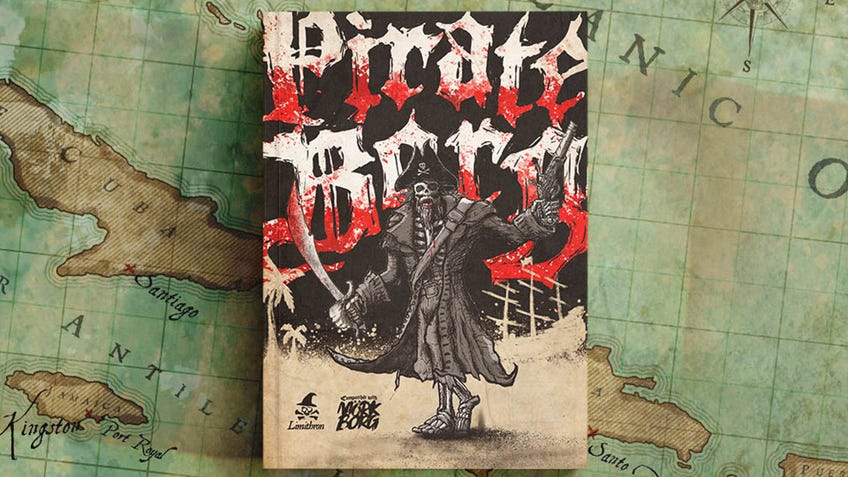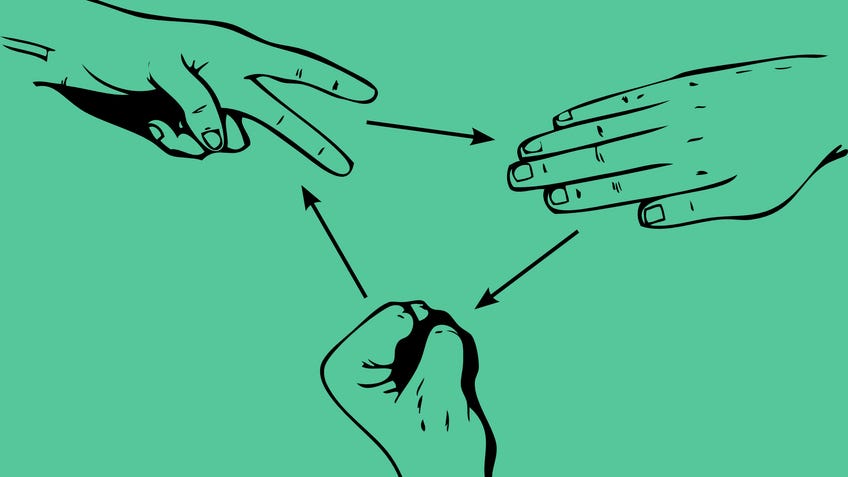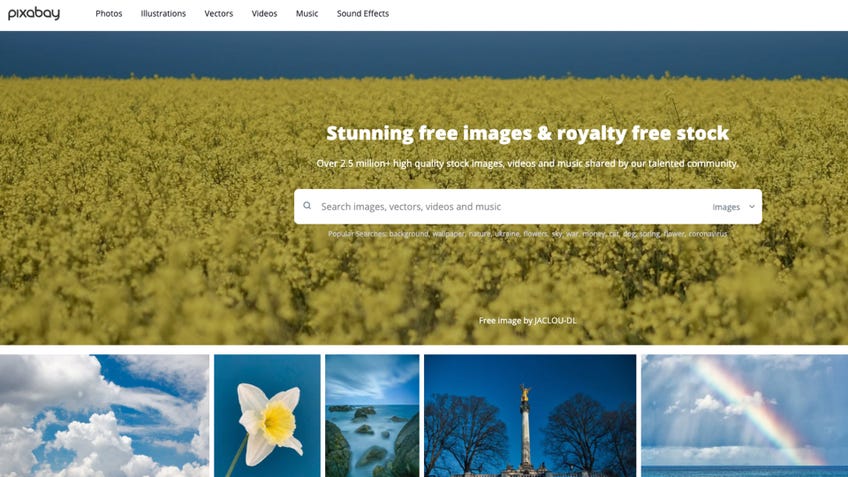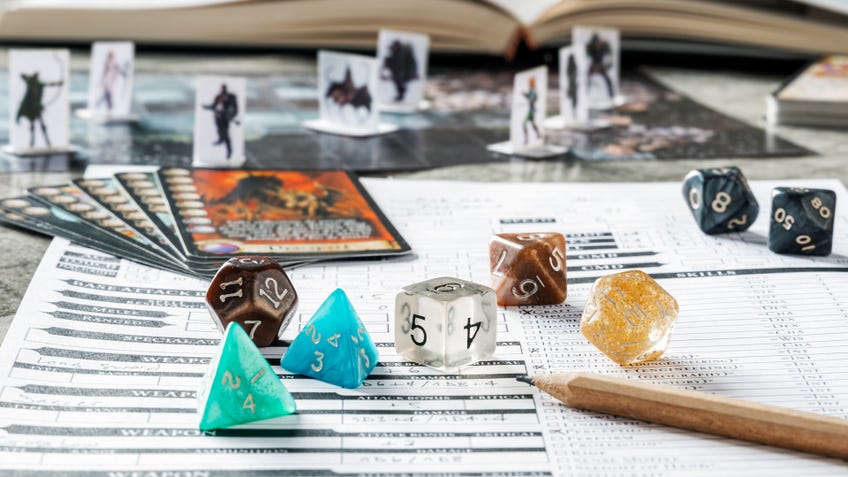How to make a roleplaying game
From using an existing RPG system to making your custom hack fun to play.
Hello there, aspiring game designer! If you’re reading this, you’ve begun to step out of the comfort of reading and playing tabletop RPGs, and into the vast and wonderful world of RPG creation. Maybe you’ve got ideas and want to explore how to bring them to the tabletop by making an RPG from the ground up, or maybe you love your favourite system but want to hack it into something new. Great!
Only there’s a lot to parse when it comes to creating your own tabletop RPG, and it might be a little daunting to dive straight in. That’s why this guide on how to make an RPG will help answer some of your questions about how to write, rewrite, hack and come out the other end with a game system that’s ready to play.
How to make an RPG
- What needs to be included in my RPG?
- Can I use existing systems and characters in a custom RPG?
- What kind of stories and themes can I tell in my RPG?
- So, what are mechanics?
- How do I make my custom RPG engaging?
- Once I’ve written the text, how do I upgrade my game?
- How can I distribute my custom RPG?
- Is making an RPG hard?

What needs to be included in my RPG?
If you’re looking at a chunky series of manuals and thinking that your own roleplaying game needs to be a mega-tome of epic lore, DON’T PANIC! A tabletop RPG does not have to be that big OR thick in order to be playable and fun. At its core, here’s what you should strive to include in your system:
- Your basic resolution mechanics, which is how players resolve in-game problems, obstacles or situations that require more than simply roleplaying. You can choose to create your own resolution system, or use an existing one like Carta’s card grid for exploration, 24XX’s varied polyhedral dice or even Rock Paper Scissors. You could even pick and choose the things you like best from a number of different systems, in order to make your ideal RPG system.
- The type of stories your RPG suits best. If you have a core theme or setting this is where it applies, but if you’re creating an open-ended system then you can opt to just give advice on what you think works with the system you’re creating.
- HOW to tell stories in your system, for both players and game masters. This doesn’t need to be very extensive, but should provide a framework for how to keep the game engaging - think plot nuggets and gameplay loops, character creation, and encounter design.
- Any extras that you think will help enhance the game system. Character sheets, player references, tables to generate small plot hooks and names, anything and everything that will facilitate a better game experience. RPGs can be daunting if those getting into them don’t feel supported, so don’t be afraid to provide those support systems.

Can I use existing systems and characters in a custom RPG?
While you can’t technically get in trouble for using game mechanics without credit when making your own RPG, since you can’t copyright mechanics and nobody can tell you otherwise, it’s considered good form to give credit where credit is due. Some mechanics, such as the idea of rolling a d20, are very generalised. However, there are more organised examples of game and system licences, such as the D&D 5E Open Game Licence, the Mörk Borg Licence and indie publisher Rowan, Rook and Decard’s Community Licence among others. Plus, creators love to see their systems being put to good use, and more often than not will be happy to help promote your game if you tag them on social media!
As for using existing characters, worlds and concepts, if you’re making a direct copy of something from an existing franchise then it would almost certainly be a fanwork. The rules on being able to earn money from producing fanworks will usually vary from franchise to franchise, so do your research if you want to make a direct adaptation. Spiritual fanworks, on the other hand? Very doable, and not copyright infringing! Feel free to make your love letters to the things you enjoy.
What kind of stories and themes can I tell in my RPG?
Short answer: anything and everything, so long as it fits within your mechanics and your vision.
Long answer: your mechanics will inform your stories, and your stories will inform your mechanics. Mechanics and systems are crucial to establishing a mood, and pairing the right story with the right mechanics can make or break player immersion. While making an RPG yourself means you can tailor make it to your needs, it can be difficult to balance - particularly if you’re not yet experienced in game design. Adapting or hacking an existing RPG system may be more suitable to your needs, but bear in mind that you need to consider the needs of your game before choosing what you work from. For example, it may be difficult to create a meditative game in XD6, which is all about explosive pools of d6 dice, or a guns-blazing action game in the ever-branching and prompt-based Threads of Lachesis.
Your vision, on the other hand, is all about what kind of story you can see being told using the tools that you create. When we play a roleplaying game, more often than not we are participants in some kind of story. It might be about searching through dungeons and besting dragons, or it may be about defeating aliens in the far future, but there is a narrative that you as a creator want expressed by the table. Work through themes and important story beats for GMs and players to draw from easily. This might seem intimidating to start, but you can also draw ideas and inspiration from sources well outside the realm of tabletop RPGs. Allow yourself to be influenced by anything and everything that moves you.
So, what are mechanics?
The backbone of any game, whether hacked or original, is its core mechanics. This tells you what type of attributes make up a player character (if any), what mechanic will be used to resolve conflict or forward the story, and what kind of gameplay incentives or extras you can include or remove when creating your game.
It is important to note that you are never required to include all of the facets of an existing RPG system, or to use them as is. Many of the best hacked games come from making modifications to existing rules, or additions to give them depth. For example, Rock Paper and Push centre resolution mechanics rather than a specific mood, which means they’re more blank slate than other SRDs. (SRD means System Reference Document - a handy guide on how to use, hack and implement an existing game system for your own purposes.)
Perhaps you want customisability in player characters, or ways of tracking their achievements across. In that case, you may want to take the Playbooks common to Powered by the Apocalypse rather than have a more expansive character creation process. By this process, you have adapted parts of different games to create something new, ready to be accompanied by a story.
Mechanics are a framework to build the rest of your game on, but much like wireframes they are designed to bend, be added onto and snipped off if needs be.

How do I make my custom RPG engaging?
A big part of getting people engaged is by making a strong gameplay loop. The gameplay loop describes the process that players go through during normal sessions of the game - from start to end, then back again. It will typically range from what occurs during a single session, to what can be expected from campaign to campaign play. How characters are introduced to a setting, how they interact with it and what makes the players bringing them to life come back for more.
Much like in video games, one of the cores of making an interesting RPG comes from realising this loop. How do you make a process simple enough that it isn’t tedious for the GM to officiate, while also making it engaging enough for the players? Part of this will come from the mechanics as stated above, but those mechanics should be informed by your theme and story. You don’t keep playing a game like Hitman or Control in order to press buttons, but because the delivery is presented in an exciting way. There are a thousand types of dungeon crawler, but only one written in your style and with your voice.
You may want to keep the basic loop present in the system, such as a Blades in the Dark-style briefing, job and downtime, or you may want to add some variations to the pre-existing formula. Heavens of Khepri takes the original Bad Time system of escalating consequences, but makes the gameplay loop work over a larger campaign by adding the potential for characters to improve themselves and have in-character downtime between objectives.

Once I’ve written the text, how do I upgrade my game?
Firstly: you are never obligated to do art and layout for a game to be a game. A lot of people see the standards by which tabletop RPGs both mainstream and indie have been held to and worry that their games might not be seen as professional or be respected because they’re not as glossy or art-filled. But art and layout are not the core of the game: the things you’ve written on the page, the half-story waiting to be completed by players, are already a full game.
That being said, if you want to add more oomph to your game, the most obvious avenues are by creating a fuller layout and adding art.
Layout refers to taking your text and making it look a little more dynamic, adding textual or design flourishes to be more aesthetically pleasing. Graphic/layout editors such as Canva, Affinity Publisher or InDesign will help you bring a little more character to your text, and downloadable templates can help take some of the stress out of layout. As an accessibility note, you can easily publish and distribute your game sans layout as a downloadable HTML or ePUB file using the Google Docs export options (if you work from Docs) or Pandoc (if you work in Word or Markdown).
Getting art for your games also doesn’t need to break the bank. There are a large number of collections of royalty-free or free-to-use art such as Wikimedia Commons, museum collections and even websites such as Pixabay.
How can I distribute my custom RPG?
You’ve written your game, put a little bit of polish on it and now you want people to see or buy it. Thankfully, it’s now easier than ever to do. The most well-known tabletop RPG marketplace online is DriveThruRPG, which has a wide audience but takes a 35% cut on all sales made. Itch.io has also become a larger marketplace for indie game developers, taking a smaller 10% cut on sales, though its visibility without marketing and social media becomes lower.
For the more adventurous or code-savvy, you can also choose to host games on your own personal website. This involves linking with a payment processor or market/sales hosting service like Shopify or WooCommerce and integrating it into the site itself. It means that you have more control over when you release, and don’t have to pay a cut out to these external marketplaces, but also requires much more direct setup and programming work.
Is making an RPG hard?
Making a roleplaying game doesn’t have to be difficult. There are so many tools, guides and ways to make and present your game to the world. Making a game is only as difficult as any other project - as long as you have the determination to finish a project, and the willingness to learn, anyone can make an RPG.


